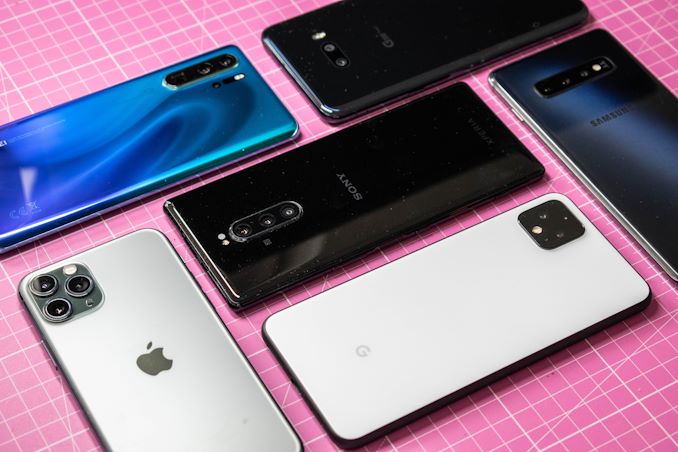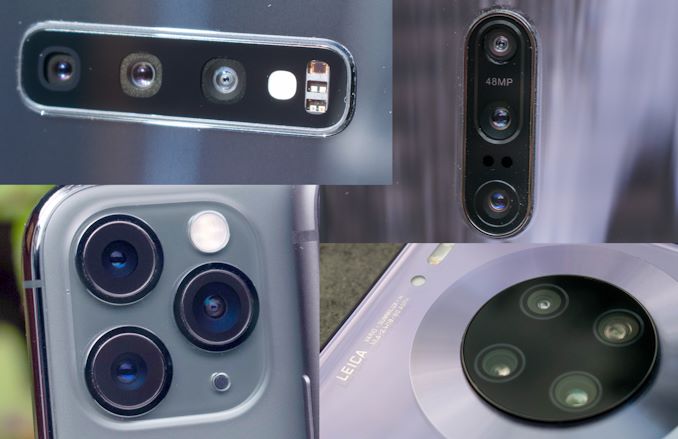AnandTech Year In Review 2019: Flagship Mobile
by Andrei Frumusanu on December 26, 2019 8:00 AM EST
2019 is coming to an end, and it’s time again to look back at what the industry has brought us. This year, we saw a lot of hardware improvements from all the various vendors, with a big focus on bringing out new distinctive designs. We’ve seen some exotic devices in the form of foldable phones for the first time ever, and even some more traditional designs dared to implement design cues such as mechanical pop-out cameras. While designs were sometimes the main differentiating factors, most of the time the key selling points of 2019 devices were big upgrades in their camera capabilities. Here we’ve seen huge leaps from almost all the vendors, and the year definitely will be remembered mainly for the innovations in photography.
Triple Cameras Become A Must-Have in 2019
Undoubtedly the biggest trend in 2019 devices, affecting both design as well as features, has been the standardisation of triple-camera setups. A trend started in 2018 by Huawei, it’s essentially become a main-stay of almost every flagship device in 2019, and a must-have for any phone which takes photography seriously. The feature is now so widespread that we’ve even seen it trickle down to the mid-range, and even sometimes lower end devices.
In most cases, the new module being added to the camera array was the ultra-wide-angle unit. The UWA isn’t exactly a new innovation; LG was the first in the industry to employ it several years ago, and Huawei last year perfected it in the Mate 20 and 20 Pro by dramatically raising the bar in terms of picture quality.
The adoption of the UWA by Samsung, Apple, OPPO, OnePlus, Sony, Xiaomi and many others means that the new camera perspective is ubiquitous for almost all 2019 devices, and it’s a fantastic addition to the capture experience not only for still pictures, but also for video recording.
We’ve also seen some innovations on the telephoto modules by some vendors. Huawei and OPPO here are the two main vendors who attempted to differentiate themselves through implementing high level optical magnification in their units. This was mainly achieved by using a more innovative right-angled orientation of the camera sensor inside of the body of the phone, viewing the outside world through the help of a mirror prism. The system does work very well to achieve high magnification levels, however the limitation of the sensor size as well as the very small aperture of the optics systems generally results in lesser picture quality in terms of exposures or dynamic range, to the point that I found these systems to be more or less just simple gimmicks, rather than practical competitors more traditional optical 3x magnification modules.
Sony’s IMX586 – An Absurd Amount of Design Wins
The very first IMX586 device we’ve reviewed this year was the Honor View20 in January. Following that, we’ve seen a stupendous number of smartphones employing Sony’s new sensor. It’s been employed by Honor in many more product ranges, it’s the sensor powering Xiaomi’s flagship devices, OnePlus’s 7-series uses the new sensor, OPPO features it in their Reno devices, ASUS has it as the main sensor for their Zenfone 6 and ROG Phone II, and it’s used in a plethora of other devices from Realme, Lenovo, Samsung, Vivo, Nubia, and others.
I don’t think we’ve ever seen a single camera sensor have so much design wins in the industry as the number of phones featuring it is pretty absurd. Whilst the IMX586 isn’t the first modern high-megapixel mobile sensor, that title still goes to Huawei’s exclusive 40MP units introduced last year with the P20’s, it’s been the sensor that has popularized the new sensor technology for the mass-market. (Yes the Nokia 808's sensor was technically first; but with very different technology and no adoption)
Sony here has triggered a new trend, and frankly I’m not sure it’s based as much on technical merit rather than the marketing power of the 48MP figure. As we’ve seen in numerous reviews this year, phones with the quad-Bayer high-MP module didn’t necessarily perform any better than more traditional lower resolution Bayer sensors. In fact, it seems a key selling point of the IMX586 was that it wasn’t necessarily a high-end sensor, and was thus cheaper to produce and sell to vendors, hence its popularity across a wide range of phones at different price-points.
For 2020, it seems that Samsung LSI is aiming to disrupt the high-MP camera sensor market even more with their introduction of 64MP and 108MP sensors. The first devices with the new sensor generation have already been released, and I think the 108MP model featuring a new humongous 1/1.33” sensor size is very promising. It’s rumoured Samsung will be released their next-gen Galaxy-S with a sensor of this calibre, which will be very interesting to see how that pans out.
Computational Photography: The New Normal
Computational photography has been one of the key innovation points of 2018 – it’s been mostly been pioneered by Huawei with the introduction of a tripod-less night mode in last year’s devices. Google was a quick follower with the introduction of Night Sight in the Pixel 3, but other than these two vendors, it still was a rather rare or inexistent aspect to photography for most devices.
2019 has now completely changed this around, and much like the new triple-camera setups, having computational photography modes exemplified by dedicated Night Mode has been a must for most vendors. The vastly improved computational processing power of new SoCs has made this possible for essentially all device vendors, however we’ve seen that software plays a much bigger role, and device vendors need to invest in a lot of R&D into enabling the features.

[ Mate 30 Pro ] - [ P30 Pro ]
[ S10+ (S) ] - [ S10+ (E) ]
[ iPhone 11 Pro ] - [ Pixel 4 ]
[ G8X ] - [ Xperia 1 ]
Samsung notably started the year with the release of the Galaxy S10 without such a mode, but was able to add it in a firmware update in May, continuously improving it over the course of the year, and also making it a key feature during the launch of the Note10 in August.
Apple’s introduction of Night Mode as well as Deep Fusion also finally brought computational photography to iPhones – Deep Fusion particularly was an industry-first which brought new levels of detail to still photography.
Other vendors are also hanging in there – the implementations here range from bad (Xiaomi), to excellent (OPPO). The software development aspect of the camera firmware and processing means that things are continuously changing, and a device reviewed earlier in the year most certainly won’t showcase the same results if it were to be tested now. This also puts a lot of pressure on vendors to be able to deliver a representative implementation early on as it’s rare for reviews to go back and be updated. Alongside always having the same environmental test conditions, this has been another key reason why I always re-test the complete device line-up, in order to have the most up-to-date comparisons between devices for each new review, so make sure to always check out the newest pieces even if it’s about some other device that might not interest you.











54 Comments
View All Comments
s.yu - Thursday, December 26, 2019 - link
What I'm trying to say is that, HDR+ had a mid-2017 release, almost a year before the horrendous night mode that debuted on the P20.drexnx - Thursday, December 26, 2019 - link
great article, I enjoy the retrospective of the trends and products that defined this year in phones.a 2010-2019 version would be awesome too, lots of stories in the past 10 years (rise and fall of HTC, WM7-8-rip, nokia, blackberry, etc.)
Urufu - Friday, December 27, 2019 - link
I am not buying Apple no matter how "good" they are. The anti repair mechanisma built into the devices ensure I will stay well away.MarcusMo - Friday, December 27, 2019 - link
Repairability of smartphones is an issue, but not one unique to Apple. In fact amongst the current crop of high end smartphones, the iPhones score the highest repairability scores (6) according to iFixit. The Pixel 4 XL scores 4 and the S10 scores 3 in comparison.https://www.ifixit.com/smartphone-repairability
TheinsanegamerN - Friday, December 27, 2019 - link
Apple is also the only manufacturer that puts in steps to make sure you can only use their special parts, and if apple or an apple certified tech does not do the repair, you lose some features of the phone.The score isnt everything.
MarcusMo - Friday, December 27, 2019 - link
Most manufacturers void the warranty if serviced by unauthorized service technicians or if you don't use original parts. And that's a good thing for the vast majority of consumers.Requiring service centers to be authorized makes repairs and their results reliable. Would you like to go to a repair shop, that is self taught and damages your phone? Or would you like to go to one that installs a super cheap battery with the wrong specification that is a fire hazard? And how would you know the difference between those shops and good ones without any authorization program?
I understand that there is a small minority of users who would like to do repairs themselves to spare a buck or two, (such as maybe yourself) but they are the exception. Most people just want to trust their repair guy, and not burn the house down.
s.yu - Friday, December 27, 2019 - link
Wow, lol, "a buck or two". Apple charges over $100 for a damned battery that costs ~$10 otherwise.And FYI "super cheap" batteries are still generally safe, because the reality is lithium batteries are super cheap in the first place. A cell made by Sony cost me $4 w/ delivery (you won't get that delivery in the US, granted) that's thicker than the one in my Logitech BT mouse but easily fits and is twice the capacity. Yes, twice. In fact you could imagine that a full sized office mouse could easily fit 3000mAh with nothing else in there but a circuit board and a few actuators, but the original was 500.
It was made intentionally small, so small that the package would not follow the cell at the edge because it's too thin. The side of the package, which was a rigid aluminum strip, was ~1mm taller than the cell, while the cell itself was ~2mm thick. The strip was the same height on the replacement cell so I suspect that it's industry standard, while the super small size was a made to order "Logitech cheapo special".
It was stuck to its socket with an adhesive so strong that I punctured the cell's packaging while removing it releasing a sour odor. Of course it said "removal of the original battery could result in fire".
Typical planned obsolescence and corporate greed, but they're gonna have to use more glue and less screws if they want to pry more money from my hands just because the battery's dead. Wait, where have I seen this before...
Reflex - Sunday, December 29, 2019 - link
BTW, you can install third party batteries in Apple phones. They just display a warning in the battery properties. That's desirable given the potential for supply chain attacks, plus if I go to an authorized repair center and they cheap out on the battery, as a customer I'd want to know.I haven't found a price difference between Apple authorized and non-Authorized, shops like GadgetFix here in the northwest are authorized, cheaper than Apple and the prices between them and doing a Pixel are the same (I've had both).
MarcusMo - Friday, December 27, 2019 - link
"There’s not too much to say about the new iPhones other than they’re extremely solid phones. I do wish a new design refresh as the current one is getting a bit long in the tooth, but hopefully that’s in queue for the 2020 models."Why, whats wrong with the current design? Do you believe that just changing things around for appearance sake to be good design? Or is there an optimal phone design driven by functionality that we’re asymptotically headed towards?
I personally hope the latter is the case, since the former seems to be a pointless exercise driven by marketing and herd mentality, where functionality often is the first casualty. But I guess that depends on if you see your phone as a fashion statement or a tool.
Andrei Frumusanu - Friday, December 27, 2019 - link
For me ergonomics are far more important than appearance, because it affects how you use the phone. I find the iPhones in this regard not as advanced or good as some more recent Android devices, and the Apple phones are bulkier in the hand. Plus that, and I would prefer less bezel to increase screen real estate.